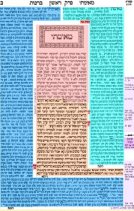|
In rabbinic Jewish thinking there are actually two Torahs: written (Torah shebikhtav) and oral (Torah sheb'al peh).
- Written Torah refers to the five books of Moses, usually taking the form of a sefer torah (torah scroll) or Chumash (book form of the first five books of Moses).
- Oral Torah refers to the word-of-mouth tradition of learning something. The idea is that God first spoke words to Moses, and then Moses responded. That is, before the actual writing down of the words of God (Torah shebikhtav) there was this dialog (Torah sheb'al peh). In Rabbinic tradition, oral Torah is considered more vital than the written Torah.

The rabbis claim that oral Torah was also received by Moses from God on Mount Sinai, and carries as much authority. However, this Torah was passed down through the centuries by word of mouth rather than the written word. Eventually this oral material was written down, beginning around the year 200 CE and culminating in the "written oral Torah" called the Talmud (which consists of the Mishnah and its commentary called the Gemarah). Note that the Oral Torah is 50 times the size of the Written Torah!
Barry W. Holtz (Back to the Sources, 1984) notes:
Ancient rabbis taught that the revelation granted to Moses had been delivered in two forms, a smaller revelation in writing and the larger one kept orally. This 'Oral Torah' had been transmitted faithfully by the leaders of each generation to their successors, by Moses to Joshua, and then to the elders, then to the prophets, to the men of the Great Assembly, to the leaders of the Pharisees, and finally to the earliest rabbis. Thus only these rabbis knew the whole Torah - written and oral - and only such knowledge could qualify anyone for legitimate leadership over the people of Israel (p.130).
Rabbi Aryeh Kaplan explains in his "Handbook of Jewish Thought" (Moznaim 1979):
The Oral Torah was originally meant to be transmitted by word of mouth. It was transmitted from master to student in such a manner that if the student had any question, he would be able to ask, and thus avoid ambiguity. A written text, on the other hand, no matter how perfect, is always subject to misinterpretation.
Furthermore, the Oral Torah was meant to cover the infinitude of cases which would arise in the course of time. It could never have been written in its entirety. It is thus written (Ecclesiastes 12:12), "Of making many books there is no end." God therefore gave Moses a set of rules through which the Torah could be applied to every possible case.
If the entire Torah would have been given in writing, everyone would be able to interpret it as he desired. This would lead to division and discord among people who followed the Torah in different ways. The Oral Torah, on the other hand, would require a central authority to preserve it, thus assuring the unity of Israel...
The Talmud also expresses this idea (Eruvin 54b):
Rebbe Eliezer learned: A person is obligated to teach his student each lesson four times. This is deduced by the following inference: Aaron -- who learned from Moses who learned it from God -- had to learn his lesson four times; how much more so an ordinary pupil who learns from an ordinary teacher.
Rebbe Akiva said: Where do we know that a teacher must continue to repeat the material until the student has mastered it? Because the Torah says (Deut. 31:19), "And you shall teach it to the children of Israel." And where do we know that it must be taught until the students know it fluently? Because the Torah says (ibid.), "Put it in their mouths." And where do we know that the teacher must also explain the reasons? Because the Torah says (Exodus 21:1), "Now these are the ordinances which you shall put before them.
A Note about the (Written) Talmud
The Talmud is the repository of "Oral Law" of Judaism, consisting of two basic parts: the Mishnah and the Gemara. There exist two versions of Talmud: the Babylonian, or "Bavli" (this is the most frequently used version) and the Jerusalem, or "Yerushalmi."
Within the Mishnah are two different types of literature. The first is known as Halachah. Halachah is literature that interprets written Torah and seeks evidence to establish judicial laws, both civil and religious, that consist of codes of behavior and religious practice and procedures (for instance, the laws of marriage and divorce, the ethics of giving charity, etc., would be considered as halachah. The second type of literature is know as Aggadah and is all material contained in the Talmud that is not halachah. It consists of the "wise sayings or tellings" of the sages. Aggadah includes stories, parables, theological or ethical statements, and homilies. Both aggadah and halacha may be found mixed together, with aggadah teaching a principle based upon a halachic text.
|



